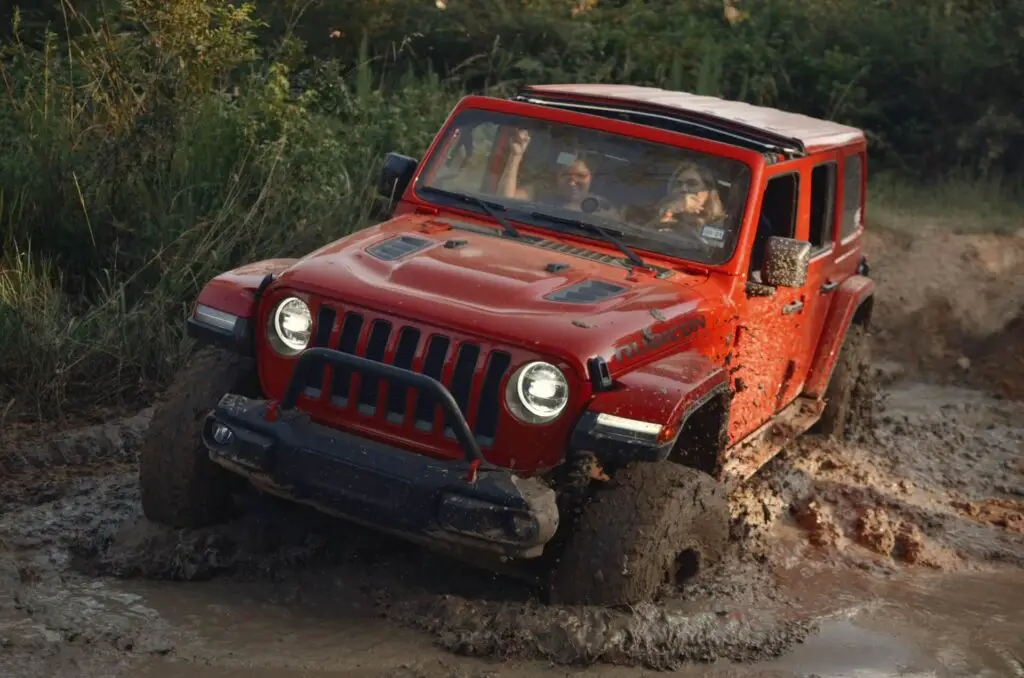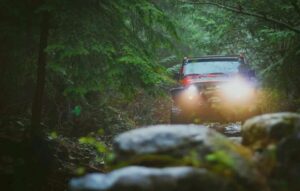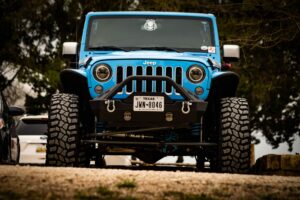Locking your hubs will certainly improve your driving experience. One thing though, that you might not have known is that at some point, keeping your hubs locked can result in mechanical problems for your vehicle.
Driving with hubs locked is a good idea but only up to a certain extent. If you are wondering when it is right not to drive with your hubs locked, we are going to be taking an in-depth look into that and more in this article.
Contents
What Happens if Hubs Are Locked?
Hubs work by a system centered on power distribution. This means that when the hubs are locked they are engaged and the opposite is true when hubs are unlocked.
When the hubs are engaged there is a difference in the overall performance of your vehicle.
The main working principle behind hubs is that they lock the ring gear which can be for either the single or dual spindle differential on your vehicle.
By locking the spindle will also cause the axle to turn at the same speed of the ring gear.
That means after locking the hubs front wheels of the vehicles connect with the front drive shafts of the vehicles. Because of that front wheels get the power from the engine when 4WD engaged.
If hubs are unlocked/ disengaged, the front wheels of the vehicle don’t get the power of the engine, even if you engage in 4WD mode.
In this kind of situation only front drive shafts will spin by engine power, but front wheels tend to spin freely because there is no connection between front wheels and front drive shafts.
But modern vehicles have automatic hub locks so they normally engage automatically when 4WD mode is activated.
How To Use Manual Locking Hubs Properly?
We have already highlighted how hubs and there is a certain trend amongst drivers to consistently keep their hubs on even when driving on dry pavement.
That is not the only wrong thing that drivers tend to do with their hubs. We are not going to get down on the wrong ways people use hubs, rather we are going to look at how to use hubs correctly.
The first thing that we have to mention is that hubs are mainly designated to help you control your vehicle easily on low traction roads.
This includes heavy snow areas as well as muddy terrain. If you mainly drive in a dry tarred or paved area, chances are you are not going to need to be using your hubs at all.
Another important element that you have to incorporate when you are using your hubs is always ensuring that your hubs are unlocked when you are out of the low traction terrain.
Using hubs is a good idea but if you keep them locked when driving on dry pavements or tarred roads, there can be some consequences.
We are going to be talking about that in-depth in this article. Once you are out of the low traction terrain ensure that you disengage your hub system.
If you go for a month without driving in low traction terrain, where there is no need to engage your hubs then it is important to make sure that once a month you engage your hubs to ensure they do not get “rusty”.
Just make sure that your hubs do not go for a very long time without being engaged. This is important, as it will help you to avoid and to detect any malfunctions.
The hubs are the easiest car component to use and to maintain. These tips will help ensure that you won’t have any problems with your hubs.
Is It Bad To Leave Your Hubs Locked All The Time?
One question you might be asking is, “Is it OK to drive with hubs locked?”. The answer is yes, but there is a condition to the affirmation.
Hubs are meant to improve the driving experience on low traction terrain. If you are driving on low traction terrains it is not only ok to drive with your hubs locked, rather it is recommended that you do just that.
Driving with your hubs locked all the time though is not ideal. This is because locking your hubs pushes your vehicle to the limits and doing that when it is necessary won’t result in problems but consistently doing it when you are driving on paved or tarred roads will often result in a lot of problems.
If you drive with your hubs locked all the time, you are most likely going to have problems with your gear system.
Having hubs engaged on dry pavements tends to put more strain on the gear system and this tends to accelerate the wear of the gear system.
Reason behind that wearing is, when hubs are engaged all the time, even without 4wd activated, your wheels spin your drive shaft and transfer case gears inversely causing unnecessary wearing of those gear components.
If you disengage hub locks when you are driving in 2WD mode, the front wheels spin freely without spinning front drive shafts.
Another reason why you are not going to enjoy driving with your hubs locked all the time is its effect on the fuel economy of your vehicle.
When Should You Lock Your Hubs?
The main principle and function of the hub locks are to ease vehicle control in low traction terrains by giving power to front wheels.
This means that there are certain instances where it is necessary to lock your hubs to ensure that you get an amazing driving experience.
One of the instances, where it is essentially important to make sure that you have hubs locked, is when you are driving on icy or excessive snow roads.
One thing about ice is that it makes the whole surface quite slippery. If you have ever driven on an icy road with a sedan then you can agree with us that it can be a real nightmare.
The same also applies to roads that have a lot of snow. Engaging your hubs will help you to maneuver and easily control your vehicle in these low traction terrains.
If you drive on muddy areas or gravel roads then you also need to engage your hubs. Unlike paved or tarred roads, gravel roads have very little traction.
This means that driving on them without egging your hubs will be a disadvantage to you and can pretty much make your driving experience subpar.
The main reason why most people tend to avoid engaging their hubs when they are driving on gravel roads is that in most instances it may be a small stretch of gravel and they get back on tarred roads.
Trust us on this one, no matter how short the distance you are traveling on a low traction surface it is always a good idea to engage your hubs.
If you also do a bit of rock climbing and crawling, off roading in mud with your vehicle that is also instances where it is completely necessary to with your hub locks on.

Rock climbing is an extreme sport and you are going to need to have all the help you can get to be able to avoid accidents.
How Fast Can You Drive With Hubs Locked?
There is no concrete speed limit when it comes to driving with your hubs locked.
Technically, it is possible to drive at your maximum speed even when your hubs are locked. The reason for this is that the hubs tend to have no restrictive effect when it comes to vehicle performance and as a result, you can drive at your vehicle’s maximum speed even when your hubs are engaged.
It is important to note though that just because it is possible does not mean you should do it. Several consequences come with driving at high speeds with your hubs locked. ‘
We recommend that if your hubs are locked you try to avoid speeds above 50 mph.
The speed will ensure safety on your end and longevity on the end of your vehicle.
If you have ever driven in off-road terrain or icy terrain then you would also agree with us that there is no need to be going at high speeds on such roads.
Driving at high speeds is even worse if you have your hubs engaged and you are driving on a paved or tarred road that is dry.
What Happens If You Drive At High Speeds With Locked Hubs?
Although it is technically possible to drive at any speed you want with your hubs locked, some consequences come especially if you are driving at high speeds with your hubs locked.
If you are trying to decide whether to go off at super high speeds with your hubs locked, here are some of the consequences that you might have to look forward to.
Fuel Economy
Well, this is the main effect of high-speed driving with engaged hubs. Engaging your hubs increases your vehicle’s overall performance and obviously, it will result in a bit of a knock on your vehicle’s fuel economy.
Now imagine adding high speed to the equation. If you do decide to drive at very high speeds with your hubs engaged you are going to notice a significant increase when it comes to your vehicle’s fuel consumption.
We have also highlighted that hubs are engaged when driving in low traction terrain.
This means that the terrain also adds to the reasons why your fuel consumption is very high when driving with hubs locked at very high speeds.
Unless you want to spend a lot of money on fuel, there is no reason to drive at high speeds with your hubs engaged.
Tear and Wear
One thing that you also have to be wary of is that driving at high speeds with your hubs locked has a significant effect on the wear and tear of certain mechanical components on your vehicle.
The main victims of the degradation that comes because of driving at high speeds with locking hubs are the front-end differential and the CV joints.
If you consistently drive at high speeds with your hubs locked it will not be a while before you hear your CV joints making that annoying screeching noise.
The gear system can also be affected by driving at high speeds with your hubs locked.
Conclusion
The working principle of the hubs is perfect but there is a need to ensure that you adhere to the tips that we mentioned in this article.
If you want to enjoy on low traction terrains, you are going to need to engage your hubs, and if you want to ensure that your vehicle does not experience technical faults be sure to disengage your hubs once you are back on dry paved or tarred terrain.
FAQ’s
What happens if only one hub is locked(While driving)?
Power will be driven to the front wheel with the least resistance. That means power will flow to the drive shaft of the wheel with the disengaged hub. (if there are no diff locks in the middle of the axle).
In this kind of situation most probably any of the front wheels will not get engine power even if one hub is locked. But diff lockers are engaged in the front axle, only the wheel with locked hub will get the power and spin.
Does 4WD work without locking the hubs?
4WD doesn’t work without locking the hubs.



